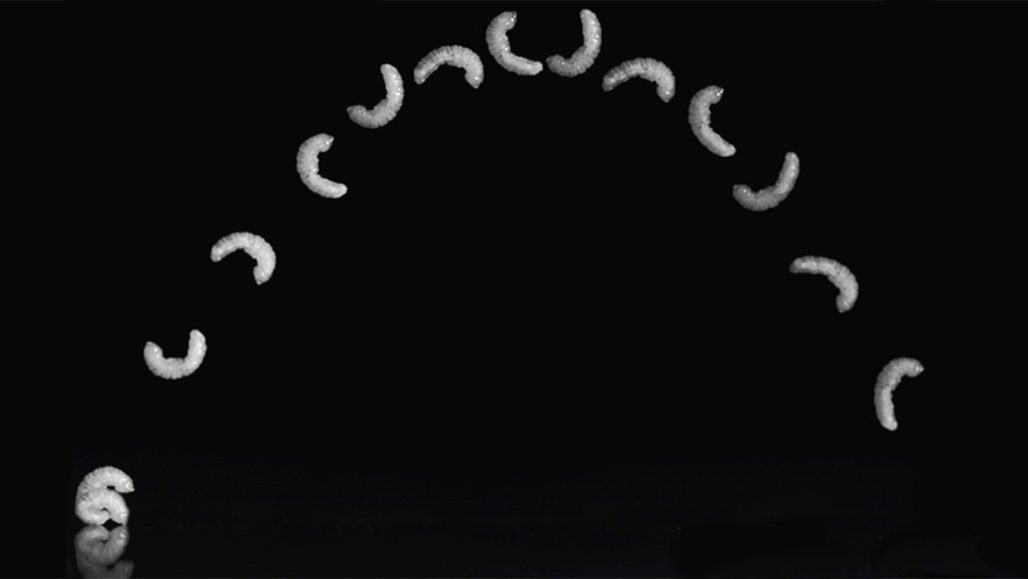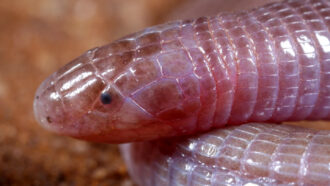High-speed camera reveals the secrets of a legless larva’s leap
The body of a larval gall midge acts like a spring

Never mind the absence of legs. A young gall midge, no bigger than a rice grain, can go airborne thanks to some clever latching.
G.M. Farley et al/Journal of Experimental Biology 2019
By Susan Milius
No legs? Not a problem. Some pudgy insect larvae can still leap up to 36 times their body length. A high-speed video now reveals how.
The bright orange larvae of a kind of Asphondylia gall midge don’t have legs. So jumping might seem impossible for them. But it’s not. First, a larva fastens its body into a fat, lopsided O. The youngster does this by meshing together front and rear patches of microscopic fuzz. The rear part of the larva now swells. Then it starts to straighten like a long, overinflating balloon. This makes the fuzzy surfaces pop apart. Like a suddenly released spring, the larva flips up and away in an arc of somersaults.
Researchers describe the midge’s feat August 8 in the Journal of Experimental Biology.
In nature, something has to go wrong for this to happen, says Michael Wise. He’s an evolutionary ecologist at Roanoke College in Salem, Va.
These midges usually grow from egg to adult safely inside an abnormal growth, or gall, that they trick silverrod plants into forming. The gall looks like a small, squashed cabbage. The larvae spend their whole childhood inside their gall. All the food they need comes from feasting on its walls.
Wise discovered the larval leaps by accident. He was trying to take larvae out of their galls early. It’s not easy. At that point, the larvae are no bigger than rice grains. He put ones he caught in a lab dish. He didn’t cover the dish because he figured anything that small couldn’t get loose. Then he went back to staring through his microscope at galls. When he checked the dish later, though, most of the larvae had vanished. He found some well on their way across his table. Some had jumped so many times they almost crossed the lab floor.
To get a better look at the insects’ jumps, he contacted Sheila Patek. He knew her in school. She’s now an evolutionary biomechanist at Duke University in Durham, N.C.
“He sees small fast things and thinks of his buddy Sheila,” Patek says. Her lab specializes in studying never-before-seen details of animal motion. To do this, Patek often uses high-speed video. To seem fast to her, something has to be really extreme. “The truth is, we film for people all the time, and it’s almost never small and fast by our standards,” she says. “But this actually was.”
The larval jumps filmed were too great for a tiny larva’s muscles, concluded Wise, Patek and their colleagues. Blobby little larvae were flipping themselves around with power equal to, or greater than, the oomph of high-power vertebrate flight muscles.
For small animals with limits on muscles, “it actually works better to put energy into a spring,” Patek says. Small creatures can load energy into the spring gradually until whatever is latching the spring slips off. Then, the suddenly freed spring can power extreme motion.
A closer look
Microscope images revealed hairlike structures on the larval surfaces that touched. This suggested that the tiny projections might stick together as some type of latch. Such structures could inspire new types of adhesives, Patek says.
She first recognized a latch-and-spring system in mantis shrimp. These tiny crustaceans throw punches so furiously they can smash aquarium walls. She’s also found such a system in a trap-jaw ant with killer jaws that spring shut in an instant. Says Patek of such latch-and-springs: “My guess is they’re everywhere.”
Still “latch systems are quite hard to study,” notes coauthor Greg Sutton. He investigates the mechanics of insect moves at the University of Lincoln in England. “We don’t know where the flea latch is,” for example, he says. The gall midge ends up with arguably the most clearly described system: the “smoking gun latch,” he calls it.
Tiny animals aren’t the only creatures that use latches for fast moves, says Simon Poppinga. He works at the Botanic Garden of the University of Freiburg in Germany. Not involved in the new research, he studies the biomechanics of plants. Plants don’t grow muscles at all. Still, they have ways of moving fast.
U.S. researchers have found, for instance, that sphagnum moss fires “spore cannons.” These are capsules that deform as they dry and then suddenly crack open to launch spores at 16 meters per second (about 50 miles per hour) that puff into miniature mushroom clouds.
Poppinga and his colleagues recently showed that Chinese witch hazel trees build up forces in the mature fruit that suddenly shoot out a seed rotating a bit like a bullet from a rifle. Unlike gall midge launches, though, these tree latches break when they let go. The leap of a legless seed is fast and dramatic, but it’s not repeatable. The midge, in contrast, can do it over and over.







